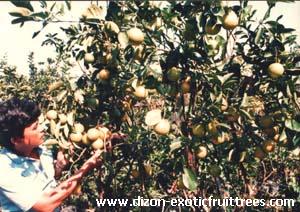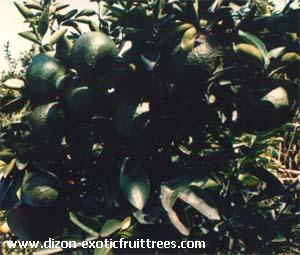 IMPORTED
oranges, popularly called Sunkist, are fruits that always
attract the consumer's eyes. Aside from looking luscious,
they are also rich sources of Vitamin C. But at the
prohibited price of P80 per kilo or P20 per fruit, oranges
have become a luxury item which the average pocket cannot
afford. IMPORTED
oranges, popularly called Sunkist, are fruits that always
attract the consumer's eyes. Aside from looking luscious,
they are also rich sources of Vitamin C. But at the
prohibited price of P80 per kilo or P20 per fruit, oranges
have become a luxury item which the average pocket cannot
afford.
A
welcome development is that imported fruits such as these
can now be grown locally. That this is not an empty claim
can be proven at the UP BLISS Economic Garden, a fruits
research and development center of the UP BLISS Community
Association. Here, grapes and oranges are successfully
grown.
Association President Fidel Coral encourages every
Filipino to plant fruit trees. He said that if fruit trees
are induce to bear quality fruits to the fullest, it could
help in earning dollars for the country. Instrumental in
attaining this goal is noted agriculturist
Bernardo O.
Dizon. He is known for developing and propagating such
fruits as miracle grapes, giant calamansi, seedless atis and
now, oranges.
Dizon has also helped set up a fruit research center in
Barangay Anupul, Bamban, Tarlac. He makes regular trips to
Capas Mayor Arnaldo. Dizon's demonstration farm where Hamlin
oranges are currently being grown.
 A one-and-a-half-year-old orange tree which measures
five to six feet can already begin to bear fruits. At three
years old, each tree can yield as much as 50 kilos of
fruits. Quick computations show that growing oranges can be
profitable venture. Once the demand for the local marker has
been satisfied, the fruit can also be exported to
neighboring Asian countries. A one-and-a-half-year-old orange tree which measures
five to six feet can already begin to bear fruits. At three
years old, each tree can yield as much as 50 kilos of
fruits. Quick computations show that growing oranges can be
profitable venture. Once the demand for the local marker has
been satisfied, the fruit can also be exported to
neighboring Asian countries.
Sweet orange is grown throughout the world but thrives
best in subtropical and tropical areas. The tree is
moderately large, measuring seven to ten meters or (22 to 30
feet) or even higher if left unpruned. As a seedling it is
erect and as it grows, strong branches spread out.
The Hamlin variety had an auspicious beginning. It was
just a chance seedling planted in a grove near Deland,
Florida by Judge Isaac Stone. The grove was later bought by
A.C. Hamlin. The variety was propagated under his name.
Among orange varieties, the Hamlin orange is the most
productive, and pest and disease resistant. The fruits
mature early and some are harvested as early as September.
The fruit is round, small to medium-sized and
commercially seedless. The peel is thin and smooth, turning
orange or yellow when ripe. Its high productivity,
seedlessness, and early fruiting make the Hamlin a popular
orange variety.
Below are some pointers form Dizon on how to grow
oranges.
* Citrus varieties of sour and sweet oranges have
similar leaves and branches. Once would only know the
difference when it bears fruits. To be sure, if you want a
Hamlin orange, get your tree only from a reliable source.
* Hamlin oranges can be planted any time of the year.
If there is irrigation, plant during dry season to get best
results. For commercial planting seedlings can be planted in
plastic bags for one year. First year growth is limited to
small areas so it can be cultivated first in plastic bags.
* Growing Hamlin orange is similar to native calamansi
culture. It can be thrive in any type of soil but grows best
in soil with a pH of 6 to 6.5. To improve pH, texture and
fertility of the soil, apply lime and organic fertilizer.
* Maintain the trunk one foot from the ground with four
branches in opposite directions. Prune the small branches on
the trunk and the other branches which are not exposed to
sunlight.
* Water regularly. During dry season, mulch the base
with two to four inches of rice hay or other dried grass to
conserve moisture.
* Apply organic (manure) and N-P-K fertilizer. Do not
use too much nitrogen or urea as these make the tree
susceptible to gummosis disease. As the tree grows, the
amount of fertilizer also increases.
* Fruiting during the first and second year should be
controlled. The type becomes stunted when induced to fruit
early. Allow only few fruits during the first two years.
* Spray the tree every 10 to 15 days with insecticide
and fungicide during the raining season and insecticide and
miticide during the dry season.
* Citrus fruits do not improve in flavor after they are
picked and should be allowed to ripen on the tree. The
fruits do not fall even after weeks or months on the tree.
Harvesting can be spread for a longer period. |

